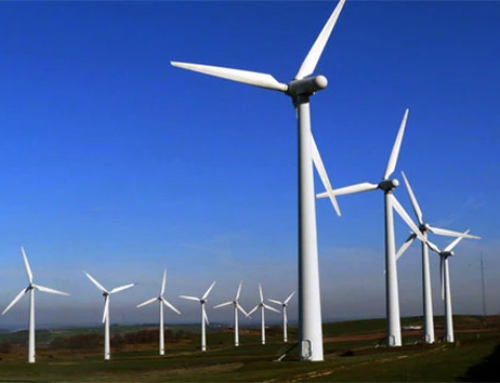India Continues to Expand Renewable Energy Resources
March 31, 2025
India Prime Minister Narendra Modi recently reiterated his pledge to more than double his country’s current renewable energy capacity, telling delegates to the India Energy Week 2025 conference in New Delhi that he wants to increase generation from renewable resources to at least 500 GW. Modi said there are five “key pillars” to reach that goal: “resource availability, a skilled workforce, economic strength, political stability, and strategic geography.” Modi said increasing development of energy is a necessity for India’s economy, and he talked about how renewable energy is key to economic growth.
India is now the world’s third-largest generator of solar power, behind China and the U.S. Government officials in February said the country now has more than 100 GW of solar power generation capacity installed across the country. Government data shows the solar power sector in India has experienced a 3,450% increase in capacity over the past decade, increasing from just 2.82 GW of capacity in 2014. Officials said that 100.33 GW of solar power capacity was in place at the end of January, with another 84 GW being built, and about 47.5 GW in the tendering stage. Government data shows 24.5 GW of solar power capacity was added last year alone.
Modi at the New Delhi event acknowledged the importance of legacy power generation—coal-fired power plants continue to produce most of the country’s electricity—and said his country will continue to work on sustainability as part of energy development. He said that the 500-GW goal for renewable energy will support a target of 5 million metric tons of green hydrogen production annually by 2030. The prime minister also said his country continues to look at the potential of its hydrocarbon resources, and is expanding its natural gas infrastructure via pipelines and power plants in an effort to increase the share of natural gas in India’s energy mix.
Challenge of Transitioning from Coal
Karuna Singh, regional director for Asia with EARTHDAY.ORG, told POWER: “India is making significant progress in the field of renewable energy; however, the transition away from coal presents a complex and ongoing challenge. Prime Minister Narendra Modi has announced that India aims to achieve net-zero emissions by the year 2070. Nevertheless, a rapid decommissioning of thermal power plants is not anticipated in the near future.”
India’s coal-powered fleet is the world’s second-largest behind China, at about 240 GW of installed capacity. Even with an expansion of renewables, the country is building more coal-fired generation, primarily state-owned facilities. A 2024 report from Carbon Brief said nearly 100 GW of new coal-fired generation is proposed or under construction in the country.
Singh told POWER that “the Indian government demonstrates a strong commitment to environmental sustainability, recognizing the imperative to reduce reliance on fossil fuels. To address this conundrum, India is increasingly turning to renewable energy sources, particularly solar energy, having made and fulfilled ambitious pledges to enhance its renewable energy capacity under its Nationally Determined Contributions framework, as part of the Paris Climate Agreement.” This commitment includes an objective of meeting 50% of the country’s total energy requirements through non-fossil fuel sources by the year 2030.
“Indian renewable energy and solar power are on the transformative curve of major change in meeting the ambitions set by an energy-hungry nation with the raised demand for continuous power,” said Manav Mittal, senior engineering, procurement, and construction (EPC) project manager at Ampirical, a Louisiana-based engineering firm that does EPC work on large-scale electric sector projects. “India ranks among the top countries of the world according to population, and it is an ever-growing economy that has posed immense hurdles to the energy requirements of its people. It has thus managed to strike at one time the recognition that solar power forms part of the solution for the buoyed power demand in the country, as well as the reduced dependence on fossil fuels, coal being the major one. Further, the country has set itself an ambitious goal of achieving 500 GW of renewable power capacity integrated with solar power as the backbone of the strategy.”
Mittal told POWER: “Solar is emerging as an affordable alternative to coal. Solar energy is becoming cost-effective quickly, and the prices of solar modules are continuing to come down, which is making diversification of the power mix just favorable for India. Since the sun is available throughout the year, India stands to boast the highest solar potential rates. Solar energy is also very eco-friendly.” Mittal continued, “Coal has been India’s core power generation source and has been synonymous with as much as 70% of electricity generation over the years. Naturally, with the expanding solar sector, a gradual displacing of coal from India’s energy mix is predicted. Solar power is not only economically viable but also has to be part of the environmental necessity of India’s future. The energy scenario in the country has a challenge directly posed to it because of expanding solar energy.”
Leader in Solar Power Capacity
Simon Stiell, executive secretary for climate change at the United Nations, at a meeting in New Delhi in mid-February, noted that India, China, the U.S., and Germany are the only countries with more than 100 GW of installed solar power generation capacity. He said the focus on an expansion of renewable energy should be on better living standards, and job creation, not just on reducing greenhouse gas emissions. “India is already headed firmly in this direction, but an even stronger embrace of the global clean energy boom will supercharge India’s economic rise,” said Stiell.
Pralhad Joshi, the New and Renewable Energy union minister, in mid-February said, “Under the leadership of Prime Minister Narendra Modi, India’s energy journey over the past 10 years has been historic and inspiring. Initiatives like solar panels, solar parks, and rooftop solar projects have brought about revolutionary changes. As a result, today India has successfully achieved the target of 100 GW of solar energy production. In the field of green energy, India is not only becoming self-reliant but is also showing the world a new path.”
Gilbert Michaud, a professor at Loyola University in Chicago, told POWER, “India is pushing for more renewables, especially solar energy, as a means to reduce emissions and gain energy security and independence. India also has a growing population and new business developments, which is increasing demand for sustainable energy solutions.” Michaud said, “Renewables are now cost-competitive with fossil fuels, making this transition even more viable. Clearly, this will have an impact on the coal sector in India. Coal-fired power generation will likely decline in the coming years. This will impact jobs in coal-heavy regions, and it will also create stranded assets for utilities. The costs and challenges of both of these are substantial.”
A program launched last year called “PM Surya Ghar: Muft Bijli Yojana” brought a surge in solar power capacity. The effort supported residential rooftop solar; officials said that as of mid-February it has resulted in almost 900,000 rooftop solar installations. Modi in an address in New Delhi said, “Every expert of the world is saying that the 21st century belongs to India. India is not only driving its own growth but also driving the world’s growth, and our energy sector plays a very big role in this.”
 |
|
1. Tata Power last year commissioned this 101.6-MW floating solar power project in the Indian state of Kerala. Courtesy: Tata Power |
Tata Power, a leading Indian energy company also known for its floating solar photovoltaic projects (Figure 1), via its TP Solar subsidiary, recently commissioned a 4.3-GW solar cell and module manufacturing facility in the state of Tamil Nadu in southeast India. The new factory is the largest single-site solar manufacturing complex in the country. The new facility is much larger than TP Solar’s Karnataka plant, which is now the country’s second-largest solar equipment manufacturing plant. Karnataka has an annual capacity of 682 MW of modules and 530 MW of cells. TP Solar said the new plant will make both tunnel oxide passivated contact (TOPCon) and passivated emitter rear contact (PERC) products, but did not specify the manufacturing capacity for each technology.
“We are immensely proud to launch this advanced solar manufacturing facility, which is a testament to Tata Power’s commitment to building a sustainable and self-reliant India,” said Dr. Praveer Sinha, CEO and managing director of Tata Power. “Not only does it showcase innovative technology, but it also plays a crucial role in community development by creating job opportunities, with 80% of the workforce comprising women.”
Incentives for Domestic Manufacturing
India is incentivizing greater domestic production of several renewable energy products, including solar cells and modules. The government in 2023 launched a production-linked incentive program, which has supported 48 GW of module manufacturing capacity. Government officials earlier this year announced a “National Manufacturing Mission” designed to support more domestic manufacturing of renewable energy equipment.
India-based Jupiter Renewables, along with Tata Power, is taking advantage of government incentives. The company in January announced plans to build a $231 million cell and module manufacturing plant in India, with an annual production capacity of 4.2 GW and 3.6 GW, respectively. Premier Energies, another Indian solar equipment manufacturer, recently paused plans to build a solar equipment manufacturing plant in the U.S., citing uncertainty about whether U.S. government support is still available under the Trump administration. The muddled U.S. regulatory environment could help India’s solar sector attract foreign investment.
Mittal told POWER, “Most importantly, transitioning to solar power will be vital to India’s energy security. Considering solar energy investments, India is actually becoming self-sufficient even with a reduced import of coal and oil, conditioned on globally indexed prices. Thus, more energy independence brings India into a position of control over its future energy scenario and stabilizes the country’s energy grid.”
Mittal said India’s solar industry is seeing foreign investment, particularly “in large-scale solar projects. The solar sector is one big driver for rural economic growth and job creation because solar projects are most constructed in rural places.” Mittal noted that coal-fired power remains “a major part of India’s energy mix,” but said the country “is doing its utmost to ensure that the renewable energy transition is a just one: cleaning up the dirty coal plants, investing in clean technology, and retraining the affected workers into new jobs in renewables.”
—Darrell Proctor is a senior editor for POWER.
Search
RECENT PRESS RELEASES
Related Post




